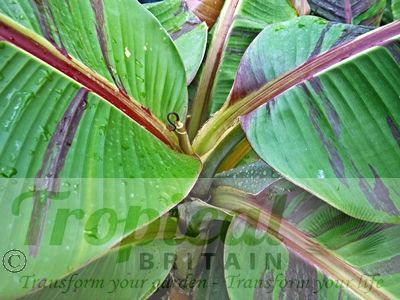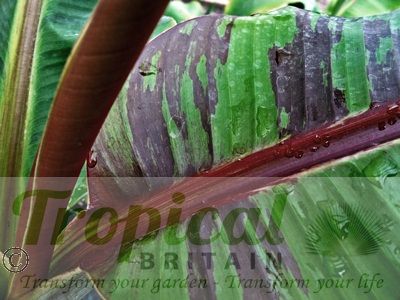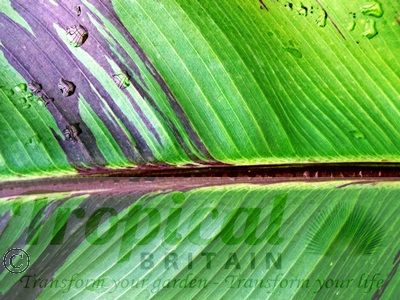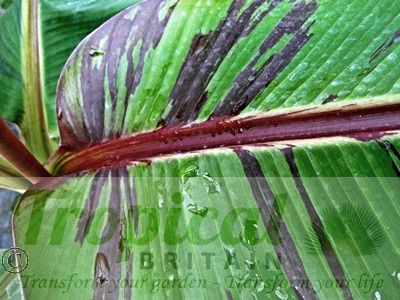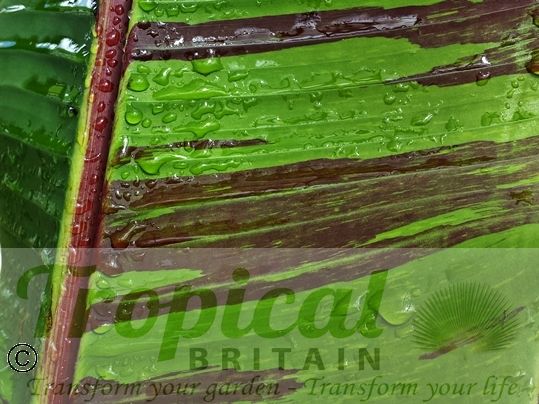Musa sikkimensis
Musa sikkimensis is a highly ornamental Musa with moroon-red foliage markings, maroon-red mid-rib and a pale metallic red on the undersides of the leaf. It is also one of the hardiest bananas and with careful thought, preparation and planning it can be overwintered in many parts of Britain. Based on experience rather than any particularly scientific study, I would probably put Musa sikkimensis second in line in the 'hardy in the UK' stakes coming in behind Musa basjoo and with Ensete lasiocapum (Musella lasiocarpa) taking the 'third hardiest' spot - although Musa basjoo is significantly hardier than either of the other two and both Ensete lasiocarpum and Musa sikkimensis need considerably more protection.
Remembering that bananas are the world's largest herbaceous perennials is always the key to overwintering them - you need to protect those roots, keeping them as well mulched and as covered as possible. The best way of insulating them is to build up more loose soil over the roots and at the base of the pseudostem and then once you have increased the soil depth start adding layers of dry mulch. It really boils down to whatever you have that is handy and readily available. Straw, hay, leaves, bracken ... anything really will do; cardboard, newspaper, bubblewrap, old sacks ... what matters is a good depth ... and layers. Remember these are not as hardy as Musa basjoo so you really do need to make some extra effort here to build up a good thick series of mulch layers. Once you have protected the roots you can think about ways to protect the pseudostem. How much of the pseudostem is lost during the winter depends to a certain extent on just how cold the winter gets. In all cases the foliage and top portion of the pseudostem will succumb to the frost. But trying to save a certain amount of height on the pseudostem is a worthwhile objective. One of the most effective and simplest methods is to wrap the pseudostem (or pseudostems if you have a larger specimen) in multiple layers of horticultural fleece - just going around and around the base and as far up the trunk as you can go. A good way to keep the fleece from actually being in contact with the pseudostem is to put an old dry banana leaf vertically down both sides before wrapping it. This keeps the pseudostem relatively dry from the inevitably wet fleece and helps to prevent rot and it also creates a layer of warm insulating air between the plant and the fleece. This will create a very effective insulation and will add considerably to the protection you are giving your precious but high-maintenance plant. With the pseudostem wrapped in this way, the Spring growth will be from the pseudostem rather than from the base giving valuable extra height. In multi-stemmed clumps, what I do is wrap each individual stem thoroughly; then further wrap the entire grouping, stuffing old leaves and whatever I can find in the space in the middle. The building of a tall cage of meshing or chicken-wire around the entire plant and stuffing the space in-between with straw and leaves is an excellent added security but if you are going to do that, my suggestion is to make sure you have wrapped it in horticultural fleece first, as described above.
The position and aspect your bananas have is an equally important consideration. The more shelter, both from the sides and from above, the better. Planted up close to the house a Musa will always benefit from the heat radiating through the walls. Tucked up in a north-easterly corner with the benefit of a shelter-belt or fence is always going to be better than out in the open. Likewise, under or close by the canopy or shelter of a large tree will give vital overhead protection from the frost. It won't stop the foliage from being lost but it will take the edge off the cold. Creating this kind of micro-climate is possible even in a relatively small garden.
All in all, this plant is a challenge in some regions but it is such a wonderful addition to the exotic garden it really is worth it.
Water it well during the summer months and treat it to regular large helpings of fertiliser and it will reward you handsomely with a magnificent display of jungle foliage.
Additional Information
| Order | Zingiberales |
|---|---|
| Family | Musaceae |
| Synonyms | Musa hookeri, Musa sapientum subsp. seminifera form hookeri |
| Geographical Origin | Himalayan foothills of North east India including Darjeeling, Assam, Sikkim and Manipur: also Bhutan. |
| Cultivation | Sheltered aspect in sun or partial shade. Water and feed well in the growing season. Mulch heavily in winter and fleece the pseudostem. |
| Eventual Height | 7 m |
| Eventual Spread | 5 m |
| Hardiness | Herbaceous perennial. Root-hardy if given adequate mulch and protection |

Free DELIVERY
ON ALL ORDERS OVER £99THIS OFFER IS VALID ON ALL OUR STORE ITEMS.

